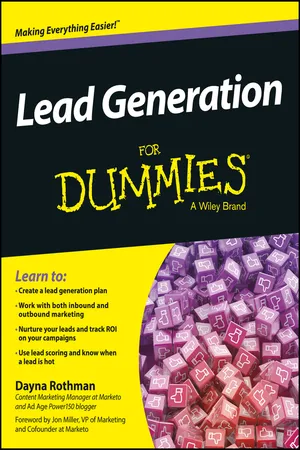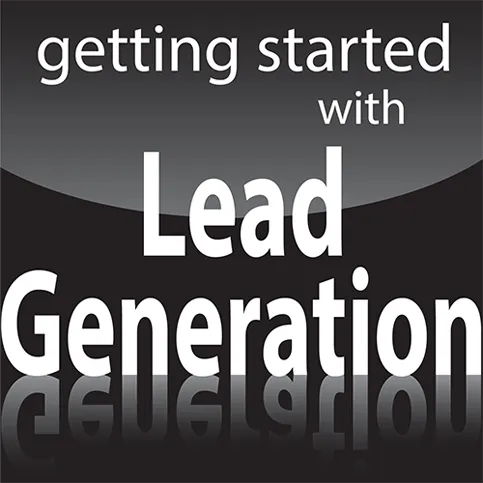Chapter 1
Beginning Your Lead Generation Journey
In This Chapter
Getting started with lead generation
Understanding the changing landscape of the marketer and buyer
Amplifying your marketing with lead generation
Forming a complete lead generation strategy
According to Google chairman Eric Schmidt, “There was 5 exabytes of information created between the dawn of civilization and 2003, but that much information is now created every two days, and the pace is rapidly increasing.” It's incredible to think about the amount of information that your customers and prospects are seeing each and every day.
In fact, SuperProfile states that “on any given day, the average customer will be exposed to 2,904 media messages, will pay attention to 52, and will positively remember 4.” The buying process has drastically changed too. No longer are buyers relying on Joe the local car salesman to help them make a decision. Instead they are doing their own research and educating themselves throughout the buying process: Think review sites, social channels, Google, and more. By the time a buyer walks into your business, she is armed with information and likely has already made a decision.
What’s more, buyer expectations are much higher. If I get back to my desk at work and discover that Chipotle has messed up my order, I don’t hesitate to send them a tweet to let them know. You would be surprised how quickly they respond. And if they don’t, I send them another tweet to let them know I am disappointed at their lack of response. As a company, you need to learn to build trust and create relationships with your buyers. If you break that trust, your buyers won’t come back. Or worse, they will tell everyone about their bad experience.
All of these factors put marketers in a complicated situation. How do you find these leads, break through the noise, and create relationships? How do you make sure your messages are heard and resonate with your audience? And how can you help your customers educate themselves through the buying process so that they ultimately choose you and your company? It's a lot to think about!
Lead generation is your answer. Lead generation describes the marketing process of engaging and capturing interest in a product or service for the purpose of developing a sales pipeline and ultimately gaining new customers.
Lead generation has become an increasingly popular strategy to create demand and help your marketing messages be heard across multiple different channels. Lead generation helps your company increase brand awareness, build relationships, drive more qualified leads into your sales funnel, and ultimately close deals. Sounds pretty great, right?
In this chapter I cover how lead generation can help your business grow by enabling you to find more leads, enhance prospect relationships, maximize your marketing spend, and ultimately, be a more strategic marketer. Plus, I go into detail on the ways lead generation connects with various marketing channels and strategies (some that you might be using today, and others that you might not have tried yet).
Growing Your Business
Whether you are a small five-person technology company just starting out, or a huge multibillion-dollar enterprise corporation, you want your business to grow. A lot. And as a marketer, you might be finding that it isn’t enough anymore to purchase an ad in a print magazine, buy a list of leads, and have your sales teams sit in a room and call on a bunch of cold prospects. In today’s multichannel world of mobile devices and social media, you need to do more than cold call to close a sale. Plus, having your sales teams call leads that are never going to buy is a huge waste of time and money.
Marketing has changed. In order to grow your business, you need to reach your buyers through many different marketing channels, such as social media, search engines, your website, events, and more. And by creating a well-thought-out lead generation strategy that maps to business priorities, you can effectively grow your business by generating more leads for your sales teams to call. The beauty of lead generation is that it covers a lot of ground if you incorporate multiple channels into your strategy.
And not only are you generating more leads, but you're generating better leads. By better leads, I mean warmer leads. What are warm leads? They are potential customers who are very close to purchasing by the time they reach your sales teams — which means happier sales executives, happier marketers, and more customers.
But how are you going to grow your business through lead generation? Stay tuned.
Finding more leads
Let me take a step back and talk about finding leads. Every business could use more leads. More leads mean more potential customers ready to buy your product or service. Finding an abundance of leads is hard — really hard. And it has become even harder and more complex due to the changing nature of the Internet and the rapid pace at which today’s businesses are expected to grow.
Marketers of yore tried to generate leads through many outbound (and often aggressive tactics) such as cold calling, batch and blast email tactics, tradeshows, print and radio advertising, and list purchasing. Although outbound techniques certainly have their place and are indeed part of a well-rounded lead generation strategy (as I discuss later in this book), used alone, they can be a turnoff to many of today’s buyers.
Modern marketers also need to employ tactics like social media, content marketing, SEO, and similar strategies to generate more (and warmer) leads for their sales teams.
In fact, the marketing team at Marketo (a leading marketing automation software provider that also happens to be my employer) generates about 80 percent of their sales pipeline. That's pretty impressive and certainly a stat that many companies aspire to. The marketing machine generates enough leads that the sales teams can focus more on selling and less on prospecting. To grow your business, this is what you want to do, and where lead generation can really make an impact.
Enhancing prospect relationships
Even more important than generating a ton of leads is generating a ton of qualified leads that are interested enough in your product or service that they could potentially become customers. Generating leads like they are going out of style won’t matter if they are bad leads, so take care. As I mentioned earlier, today’s buyer self-educates. And because of the open nature of the Internet, he has high expectations for customer service. Additionally, today’s buyer values relationships and trust, and likes to interact with brands on a more personal level through social channels such as Facebook and Twitter. He wants to be spoken with, not spoken at.
Companies today need to focus on creating relationships with leads so that when a buyer is ready to purchase, your company is top-of-mind. This is done through engaging leads with educational content, being active on social channels to develop a following, face-to-face interactions at events, and other relationship-building lead generation tactics.
Remember, the days of the faceless corporation are over. Your buyers want to engage with you as they would engage with a friend. Consumer companies like Coca-Cola, Nike, and Apple do a great job creating relationships with customers through storytelling, great branding, and creative lead generation tactics. Appealing to your buyer creates brand ambassadors, ultimately helping you grow your company and generate more high-quality leads.
Maximizing your spending
Lead generation enables you to maximize your spending as a marketer and ultimately gain greater credibility within an organization. Marketing has been increasingly pressured to produce metrics and be accountable for a budget, and is often scrutinized for wasting expensive sales resources calling on bad leads that are not qualified in any way. Because lead generation provides you with the framework for measureable campaigns, return on investment (ROI) becomes easier to report on.
Lead generation helps you focus on program ROI, evaluate leads to determine sales-readiness, and nurture leads that are not quite yet ready to buy. By being focused and strategic with your lead generation strategy, you can truly begin to maximize your marketing spending while making sure you are focusing on sending qualified leads to sales.
Additionally, tactics like social media, blogging, content marketing, your website, and SEO give you a huge bang for your buck. Instead of renting attention, as you would in paid programs, you are owning your own attention. What is the difference? Well, renting attention is paying someone to borrow their audience — like an event or a paid ad. Owning attention is the ability to develop your own following through content marketing and social media. And when you combine these techniques with paid programs such as events, email marketing, and inside sales, you can truly maximize your spending.
Being more strategic
Creating an integrated lead generation strategy for your business enables you to capture and nurture leads in a more strategic way. Many...






